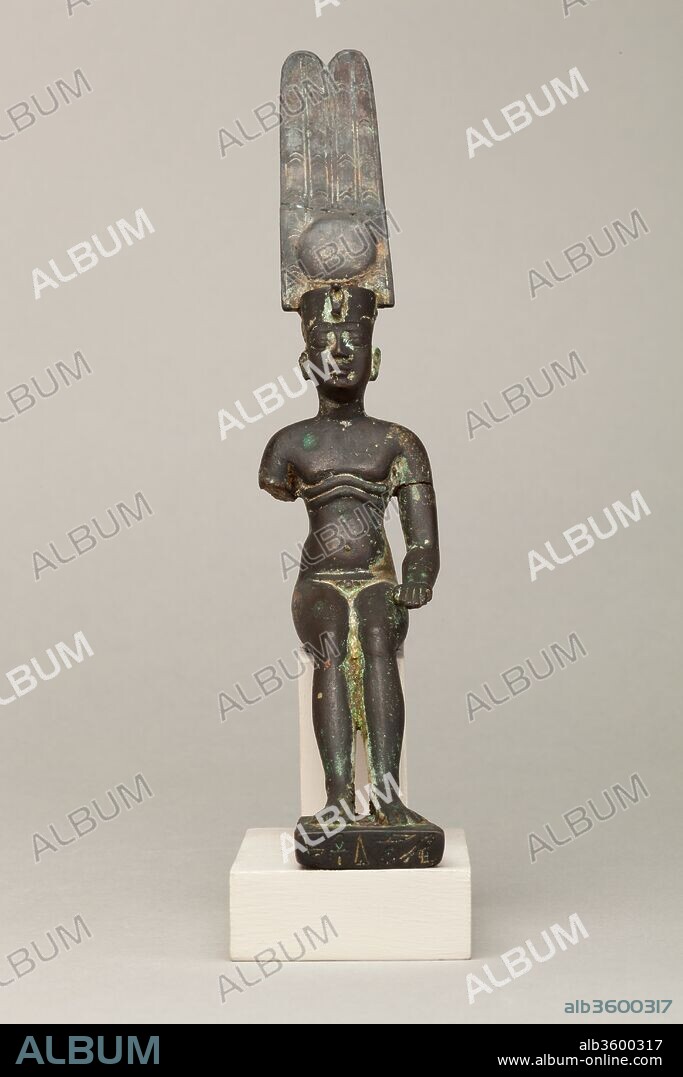alb3600317
Child god wearing Amonian crown and named Horus of Mednit (Aphroditopolis)

|
Ajouter à une autre Lightbox |
|
Ajouter à une autre Lightbox |



Avez-vous déjà un compte? S'identifier
Vous n'avez pas de compte ? S'inscrire
Acheter cette image.
Sélectionnez l'usage:

Titre:
Child god wearing Amonian crown and named Horus of Mednit (Aphroditopolis)
Légende:
Traduction automatique: Dieu enfant portant la couronne amonienne et nommé Horus de Mednit (Aphroditopolis). Dimensions : H. 18,3 cm (7 3/16 in.) ; W. 4 cm (1 9/16 in.) ; D. 11,1 cm (4 3/8 in.). Date : 664-30 av. La figure représente un enfant dieu en position assise/couchée, coiffé de la double couronne de plumes, qui l'associe au dieu Amon. Le dieu enfant se distingue généralement des dieux adultes par une série d'indices iconographiques : sa nudité, le doigt levé vers la bouche (un geste enfantin) et une mèche sur le côté droit de sa tête. Le bras droit de cette figure est cassé, et donc la position de la main est inconnue ; il était probablement tenu à sa bouche ou à ses côtés, comme le bras gauche. Le sidelock n'est pas non plus en évidence, mais sa nudité suffit à l'identification en tant qu'enfant dieu. En dessous de ses pectoraux, l'enfant dieu porte deux bourrelets stylisés, caractéristique très rare sur ce type de statuettes. Néanmoins, de nombreux enfants dieux sont représentés avec des ventres arrondis ou potelés, mettant en valeur la capacité du dieu à apporter prospérité et abondance; ces gros boudins expriment les mêmes idées. Les dieux enfants ont gagné en popularité et en culte à partir de la troisième période intermédiaire, rivalisant même avec les dieux les plus puissants et les plus anciens, en particulier en tant qu'offrandes de temple. En raison de leur profusion et de leurs nombreuses formes locales, il est généralement très difficile d'attribuer des identités précises aux enfants dieux, mais une inscription sur la base nomme cette figure Horus de Mednit.
Child god wearing Amonian crown and named Horus of Mednit (Aphroditopolis). Dimensions: H. 18.3 cm (7 3/16 in.); W. 4 cm (1 9/16 in.); D. 11.1 cm (4 3/8 in.). Date: 664-30 B.C..
The figure represents a child god in a seated/reclining position, wearing the double feather crown, which associates him with the god Amun. The child god is usually distinguished from adult gods by a range of iconographic clues: his nudity, the finger raised to the mouth (a child-like gesture), and a sidelock on the right side of his head. The right arm of this figure is broken, and thus the position of the hand is unknown; likely it was held at his mouth or at his side, like the left arm. The sidelock also is not in evidence, but his nudity suffices for identification as a child god. Below his pectorals, the child god has two stylized fat rolls, a feature that is very uncommon on these types of statuettes. Nevertheless, many child gods are shown with rounded or chubby bellies, showcasing the god's ability to bring about prosperity and abundance; these fat rolls express the same ideas.
Child gods grew in popularity and cult from the Third Intermediate Period onwards, rivaling even the most powerful and ancient gods, especially as temple offerings. Because of their profusion and many local forms, generally it is very difficult to assign precise identities to child gods, but an inscription on the base names this figure as Horus of Mednit.
Technique/matériel:
Cupreous metal
Période:
Late Period-Ptolemaic Period
Musée:
Metropolitan Museum of Art, New York, USA
Crédit:
Album / Metropolitan Museum of Art, NY
Autorisations:
Modèle: Non - Propriété: Non
Questions sur les droits?
Questions sur les droits?
Taille de l'image:
2934 x 4400 px | 36.9 MB
Taille d'impression:
24.8 x 37.3 cm | 9.8 x 14.7 in (300 dpi)
Mots clés:
 Pinterest
Pinterest Twitter
Twitter Facebook
Facebook Copier le lien
Copier le lien Email
Email
